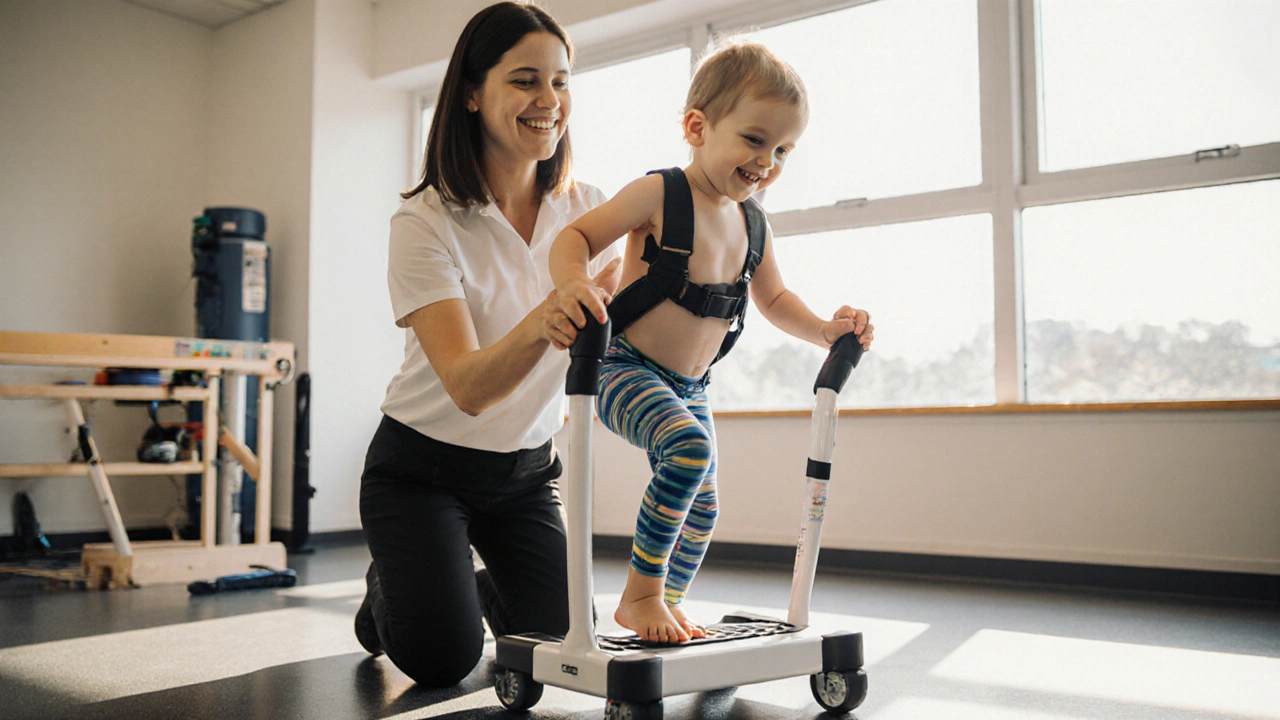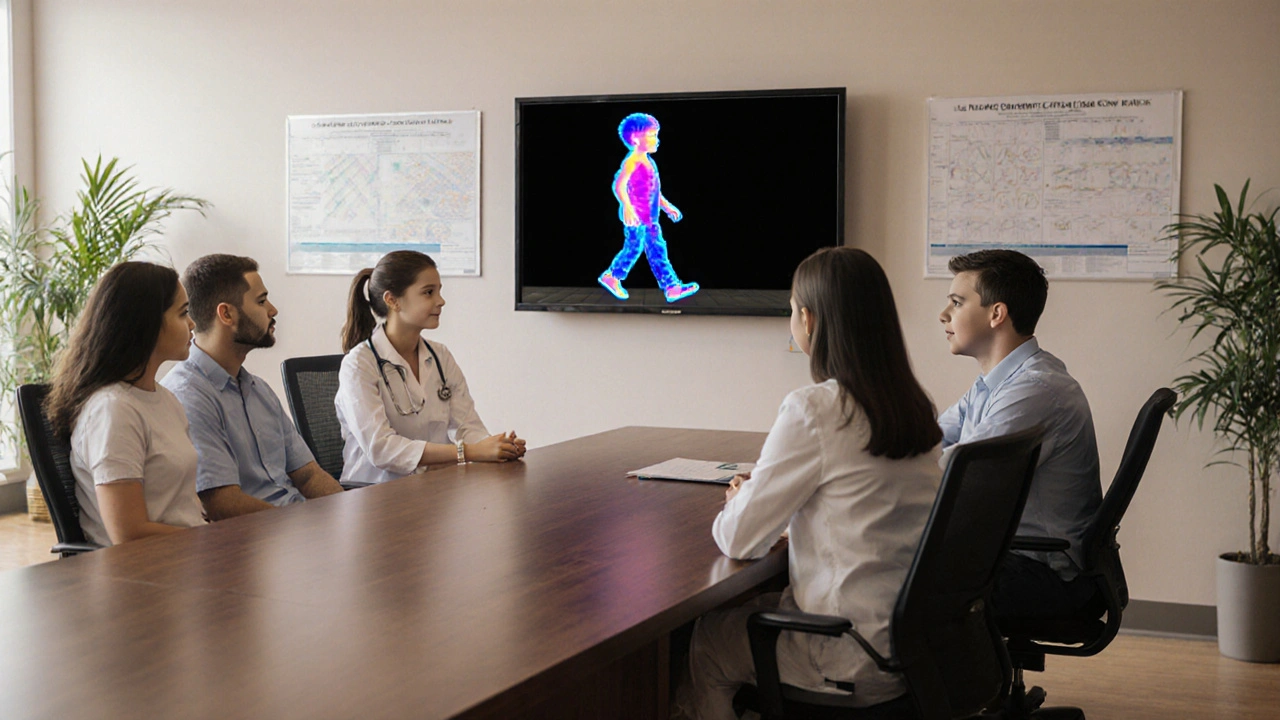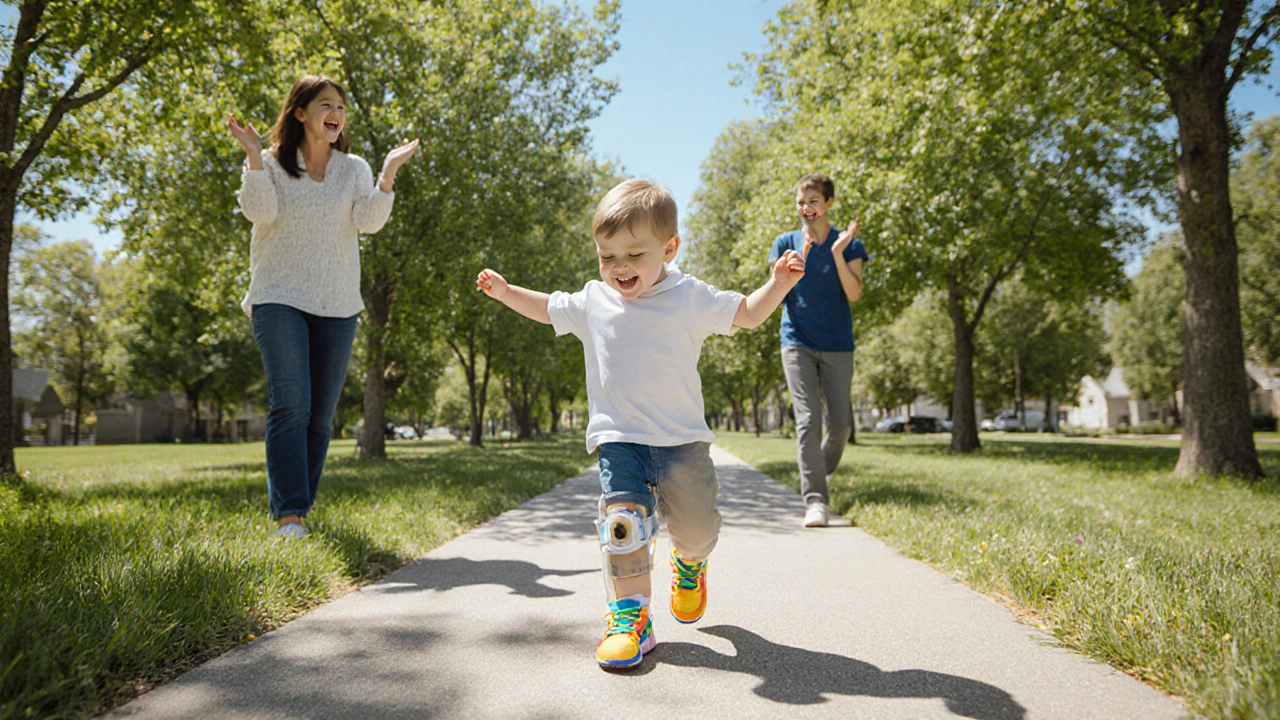 Sep, 26 2025
Sep, 26 2025
Physical therapy is a rehabilitative discipline that uses movement, exercise, and functional activities to improve strength, flexibility, and motor control, often delivered by a licensed physical therapist. When applied to children with cerebral palsy, the goal shifts to maximizing mobility and participation in everyday life.
Understanding Cerebral Palsy and Mobility Challenges
Cerebral palsy (CP) is a group of permanent movement disorders caused by brain injury before, during, or shortly after birth. The condition varies widely: some kids have mild spasticity, while others struggle with severe dystonia. Regardless of severity, limited mobility often leads to reduced independence, difficulty with school activities, and secondary health issues like contractures.
Clinicians use the Gross Motor Function Classification System (GMFCS) to categorize functional levels from I (walks without limitations) to V (requires a wheelchair). Knowing a child’s GMFCS level helps therapists set realistic goals and choose appropriate interventions.
The Core Role of Physical Therapy
At its heart, physical therapy focuses on three pillars: strengthening weak muscles, enhancing motor planning, and promoting functional movement patterns. For kids with CP, therapy is less about ‘fixing’ a defect and more about enabling the child to use their existing abilities more effectively.
Therapists start each session with a brief functional assessment, then move into targeted activities that challenge balance, coordination, and gait. Consistency matters: evidence shows that intensive, task‑specific practice over weeks yields measurable gains in walking speed and endurance.
Key Therapeutic Approaches
Several evidence‑based approaches sit under the physical therapy umbrella. Each has distinct focus, session length, and evidence level.
| Approach | Primary Focus | Typical Session Length | Evidence Level | Best GMFCS Levels |
|---|---|---|---|---|
| Neurodevelopmental Treatment (NDT) | Facilitating normal movement patterns | 45‑60 min | Moderate | I‑III |
| Task‑Oriented Training (TOT) | Repetition of functional tasks (e.g., stepping, reaching) | 30‑45 min | High | II‑IV |
| Constraint‑Induced Movement Therapy (CIMT) | Intensive use of affected limb | 2‑6 h/day (bolus) | High | I‑III |
| Strengthening Program | Muscle power and endurance | 30‑60 min | Moderate | III‑V |
| Aquatic Therapy | Reduced weight‑bearing, sensory integration | 45‑60 min | Low‑moderate | II‑V |
Neurodevelopmental Treatment (NDT) remains popular because it emphasizes gentle handling and positioning to encourage normal tone. However, recent systematic reviews favour Task‑Oriented Training (TOT) for its higher transfer to real‑world activities. In TOT, a child might repeatedly practice stepping over obstacles while wearing a harness for safety, directly targeting gait improvement.
When a child has significant unilateral involvement, Constraint‑Induced Movement Therapy (CIMT) can dramatically increase use of the weaker arm during play. The therapist fits a lightweight splint on the stronger hand and encourages the child to explore toys using the affected hand for several hours each day.
Strength training, once frowned upon for spastic children, now enjoys strong support. Controlled resistance exercises improve muscle cross‑sectional area without increasing spasticity, especially when combined with stretching.
Aquatic sessions leverage buoyancy to let kids practice walking and balance without the fear of falling. The warm water also relaxes spastic muscles, making it an excellent adjunct for children who resist land‑based stretching.
Assessment Tools Guiding Therapy
Accurate measurement drives progress. The Functional Independence Measure for Children (WeeFIM) captures daily‑living skills, while the GMFCS provides a quick snapshot of walking ability. Combining these tools lets therapists set quantifiable goals, such as increasing the 6‑Minute Walk Test distance by 15% over six weeks.
Another useful metric is the Gait Deviation Index (GDI), derived from 3‑D gait analysis. A GDI score above 100 implies near‑normal gait; most children with CP start around 70-80. Targeted interventions aim to push that number upward, reflecting smoother, more efficient steps.

Integrating Orthotics and Assistive Technology
Orthotic devices, such as ankle‑foot orthoses (AFOs), provide external support that aligns joints during stance. When paired with gait training, AFOs can improve stride length and reduce energy expenditure. Research shows children wearing custom‑fit AFOs walk up to 20% farther before tiring.
Assistive technology-including walking frames, powered gait trainers, and robotic exoskeletons-extends the therapist’s reach. For example, the Lokomat robotic treadmill delivers precise, repeatable step patterns, reinforcing neural pathways while freeing the therapist to focus on cueing and motivation.
Choosing the right device involves a trade‑off between portability, cost, and functional goals. A child who attends school daily may benefit more from a lightweight, collapsible walker than a heavy robotic system.
Collaborative Care: Multidisciplinary Team and Family‑Centered Approach
No single professional can address every aspect of CP. A typical multidisciplinary team includes a pediatrician, neurologist, orthopedic surgeon, occupational therapist, speech‑language pathologist, and the physical therapist. Regular case conferences ensure that interventions-whether surgical, pharmacologic, or therapeutic-are synchronized.
Family involvement is equally critical. Family‑centered care shifts decision‑making from the clinic to the home, empowering parents to embed therapeutic cues into daily routines. Simple strategies-like prompting a child to stand while brushing teeth or using a therapist‑recommended video for home exercises-can double the dosage of practice without extra clinic visits.
When families understand the rationale behind each activity, adherence improves, and children experience fewer setbacks during transitions (e.g., from preschool to primary school).
Practical Tips for Parents and Caregivers
- Set micro‑goals: aim for 5 extra steps per day, then build.
- Use visual schedules to remind the child of upcoming practice sessions.
- Incorporate play: turning a stepping task into a treasure‑hunt keeps motivation high.
- Track progress with a simple log: note distance walked, number of repetitions, and perceived effort.
- Communicate regularly with the therapist; adjust intensity based on fatigue signs.
These consistent, low‑stress activities often produce the biggest gains because the nervous system thrives on repetition.
Related Concepts and Next Steps
Understanding how Botox injections temporarily reduce spasticity can complement therapy, especially before intensive gait training. Similarly, knowledge of Selective Dorsal Rhizotomy-a surgical option for severe spasticity-helps families weigh long‑term benefits against recovery time.
Future reading could explore the role of virtual reality in motor relearning, or dive deeper into the science of neuroplasticity and how intensive practice reshapes cortical maps.

Frequently Asked Questions
How often should a child with cerebral palsy attend physical therapy?
Most clinicians recommend 2‑3 sessions per week, each lasting 45‑60 minutes, combined with a daily home program of 20‑30 minutes of targeted exercises.
What is the difference between NDT and Task‑Oriented Training?
NDT focuses on guided handling to promote normal movement patterns, while Task‑Oriented Training emphasizes repetitive practice of functional tasks that directly translate to daily life. Research favors TOT for faster gains in walking speed and endurance.
Can orthotic devices improve walking ability?
Yes. Custom ankle‑foot orthoses align the ankle during stance, often increasing stride length by 10‑15% and reducing energy cost of walking.
Is intensive therapy at home effective?
Home‑based intensive programs, when structured and monitored by a therapist, can yield comparable improvements to clinic‑based sessions, especially when they incorporate play and functional goals.
When should a family consider surgical options like selective dorsal rhizotomy?
Surgery is typically considered for children with severe spasticity (GMFCS IV‑V) who have not responded adequately to therapy and medication. A multidisciplinary evaluation ensures the child is a good candidate.
Maud Pauwels
September 27, 2025 AT 00:00The table you shared makes it clear which PT approach fits each GMFCS level. For parents, starting with a functional assessment helps narrow down the right option. Consistency in the home program is just as important as the clinic visits. Tracking progress with simple logs can keep motivation high.
Scott Richardson
September 27, 2025 AT 00:16Look folks, nothing beats the good old American grit when it comes to rehab. We push kids hard, we don’t waste time on fancy jargon. Simple goals and tough work get results faster. The US knows how to get the job done.
Laurie Princiotto
September 27, 2025 AT 00:36I’m not buying the whole hype about aquatic therapy – it’s just a splashy gimmick 😒. Kids need real ground work, not a pool party. 🙅♀️
Justin Atkins
September 27, 2025 AT 01:00Your article rightly underscores the shift from NDT to Task‑Oriented Training, yet one must consider the nuanced neurophysiological underpinnings that render such paradigms effective. The specificity of motor learning principles, particularly the attenuation of maladaptive synaptic plasticity, is paramount. Moreover, the integration of biofeedback mechanisms augments proprioceptive acuity, thereby facilitating more robust motor pattern acquisition. While the evidence favours TOT, clinicians should remain vigilant of individual variability in spasticity phenotypes. In sum, a tailored amalgam of NDT scaffolding and TOT intensity may optimise functional outcomes.
June Wx
September 27, 2025 AT 01:26CIMT can be a game‑changer for unilateral involvement.
kristina b
September 27, 2025 AT 01:56The intricate tapestry of human movement, when disrupted by the capricious forces of cerebral palsy, invites us to contemplate the very essence of neuroplasticity.
Physical therapy, in its most enlightened incarnation, becomes the loom upon which this tapestry is rewoven.
Each repetition of a targeted task is not merely an exercise but a deliberate summons to the dormant circuits of the cortex.
When the therapist engineers an environment of purposeful challenge, the nervous system, ever opportunistic, reorganises its pathways with astonishing alacrity.
It is within the micro‑seconds of weight‑bearing, the subtle shifts of balance, and the rhythmic cadence of gait that synaptic potentiation is forged.
Consequently, the notion that strength training aggravates spasticity is but a myth, for resistance endeavours, when judiciously applied, augment muscular cross‑section without inciting hypertonic reflexes.
Equally, the buoyant embrace of aquatic therapy offers a sanctuary where gravity's tyranny is softened, permitting the child to explore locomotion unshackled by fear of fall.
Yet, one must not overlook the ethical imperative of patient‑centred goal setting, for without the child's intrinsic motivation, even the most sophisticated regimen will languish in futility.
The multidisciplinary concert, featuring orthotists, neurologists, and speech therapists, is akin to a symphony wherein each instrument must be precisely tuned.
A custom‑fit ankle‑foot orthosis, for instance, acts as a silent conductor, aligning the ankle during stance and thereby extending stride length with elegant efficiency.
Furthermore, the advent of robotic exoskeletons, though costly, heralds a new epoch where repetitive, high‑fidelity gait cycles become accessible to clinicians and families alike.
In the realm of home programs, the incorporation of visual schedules and gamified treasure hunts transforms mundane repetitions into joyous quests, amplifying adherence.
Parents, when educated on the neurophysiological rationale, evolve from passive observers to active participants, embedding therapeutic cues within quotidian routines.
Empirical studies have demonstrated that such embedded practice can augment walking speed by upwards of fifteen percent over a six‑week horizon.
Thus, the cumulative effect of systematic, intensive practice is not merely incremental improvement but a profound reconstitution of the child's functional identity.
In closing, let us cherish the responsibility bestowed upon us as facilitators of this rebirth, ever mindful that each step forward is a triumph over the silence of neural inertia.
Ida Sakina
September 27, 2025 AT 02:30The moral imperative to provide equitable access to physical therapy cannot be overstated. Children with cerebral palsy deserve interventions that honor their inherent dignity. It is incumbent upon societies to allocate resources responsibly. Let us act with compassion and resolve.
Amreesh Tyagi
September 27, 2025 AT 03:13I think the emphasis on orthotics is overrated they can limit natural movement.
Brianna Valido
September 27, 2025 AT 04:03Keep pushing those tiny steps each day you’ll see progress 😊💪
Caitlin Downing
September 27, 2025 AT 05:00Wow the article really broke down the options – I especially love the bit about turnin therapy into a treasure hunt for the kiddos. Using bright stickers on the floor or a pirate map can make practicing steps feel like an adventure. Also, don’t forget to log the wins in a cute journal – it helps families see growth over time. And hey, if you’re feeling overwhelmed just grab a coffee and read it again, the info is gold.
Robert Jaskowiak
September 27, 2025 AT 06:00Oh sure, because nothing says ‘professional care’ like a pirate map and a coffee break, right? Maybe we should also hand out gold stars for every step. 😉